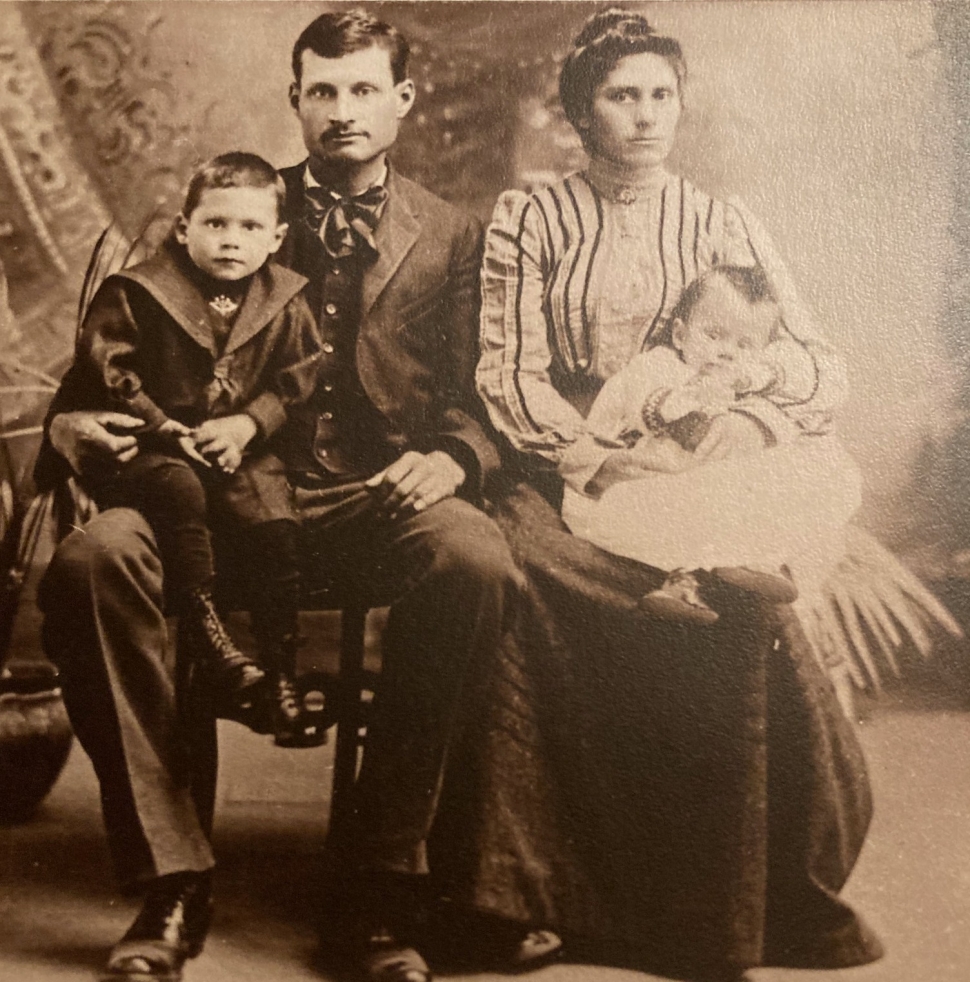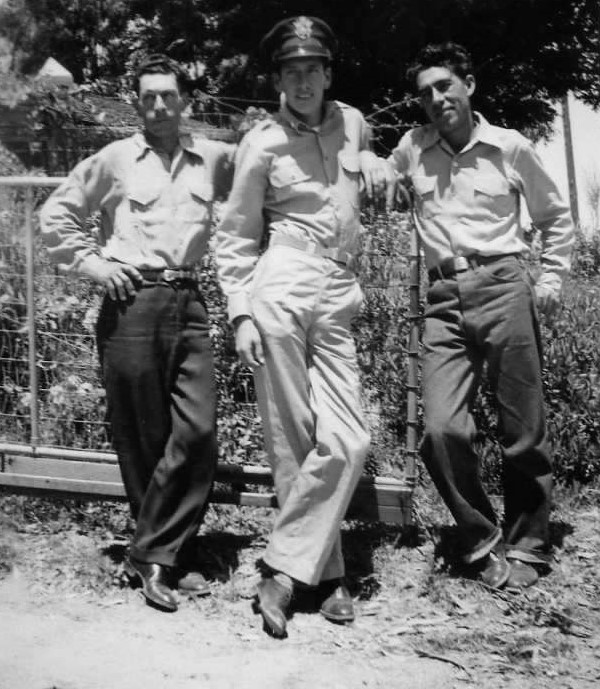
Above are the three amigos, George William, the author’s grandfather (Mark Aguirre), his father George Benjamin (in uniform) and Joe Nunez, 1944. Photo courtesy Fillmore Historical Museum.
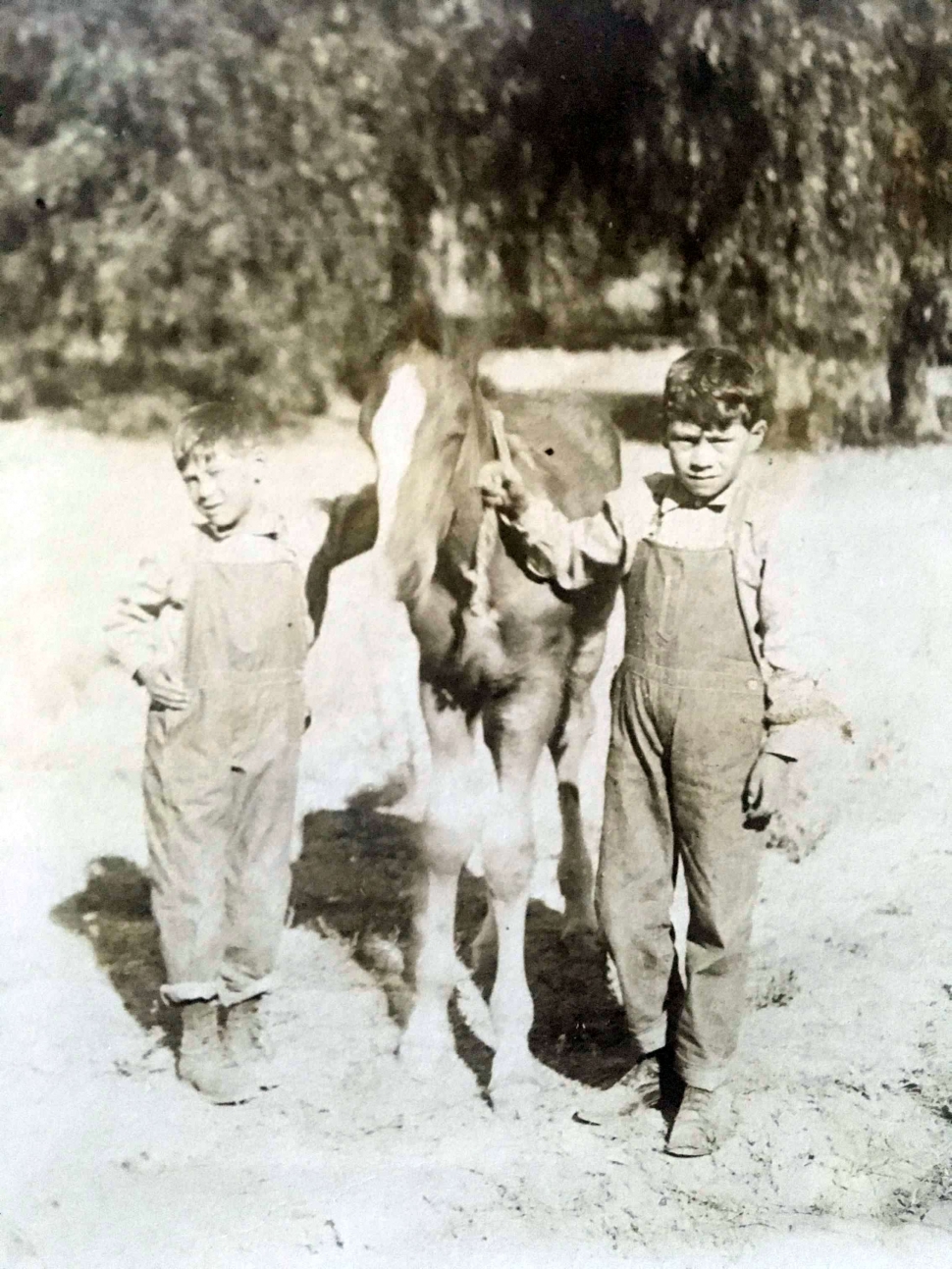
George William and his brother, Ernest Aguirre holding a colt, c 1910.
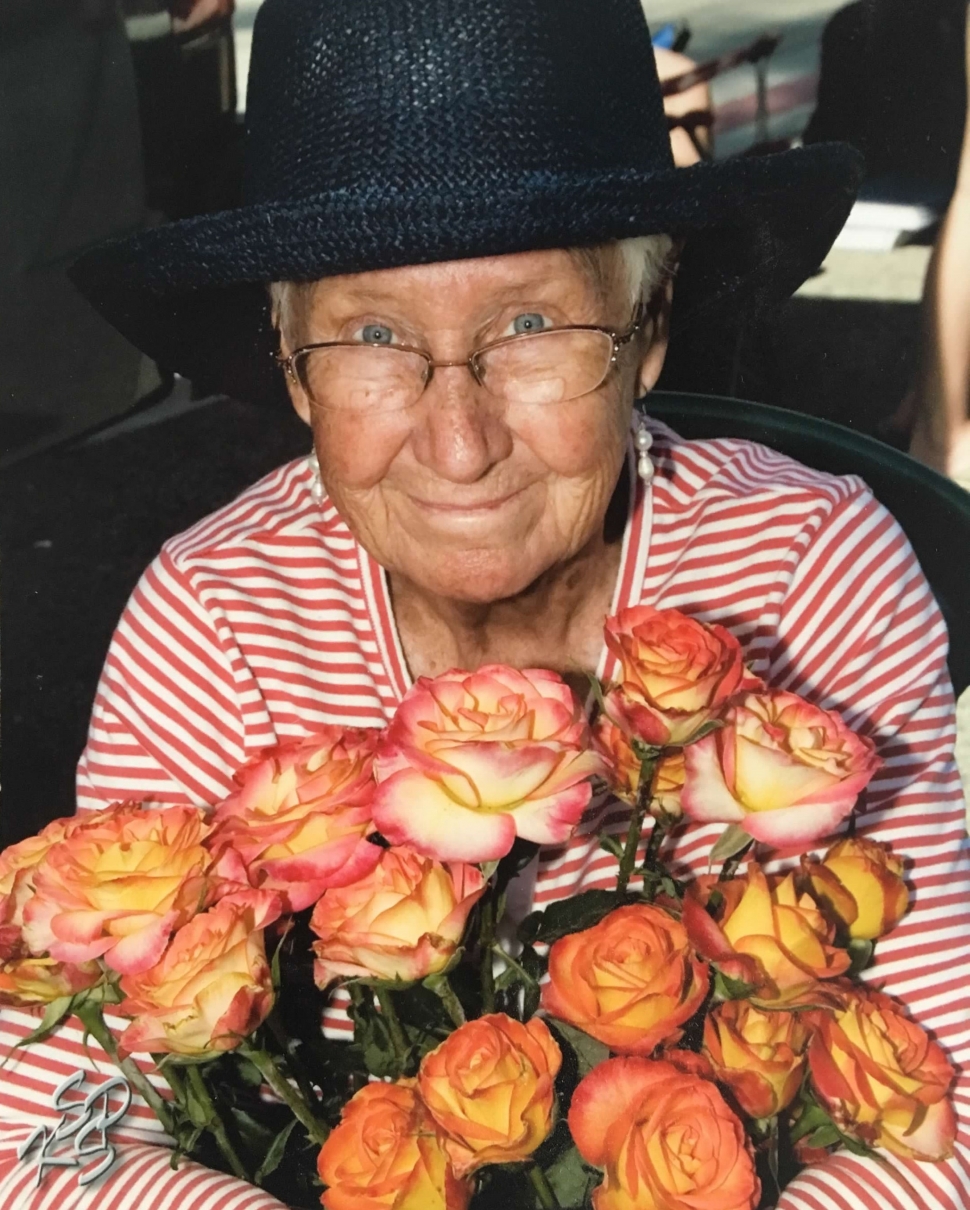
Marge Aguirre holding a bouquet of her beautiful roses.
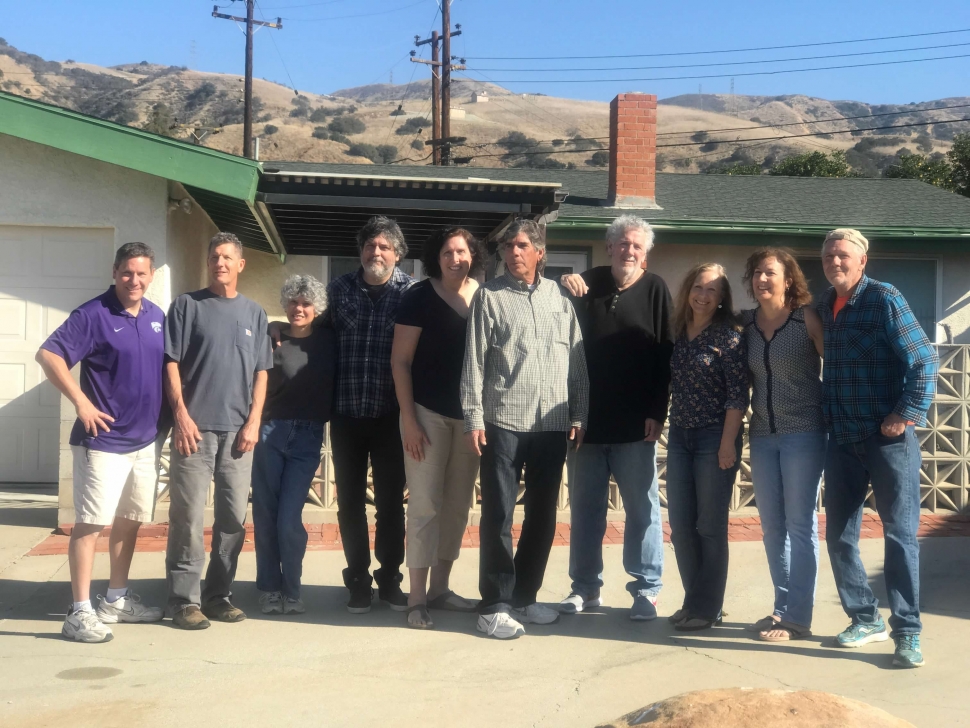
Above is a photo taken in 2018 after Marge Aguirre passing; George B. and Marge Aguirre's Children, left to right Andrew, Chris, Elizabeth, Philip, Michele, Tim, Mark, Angela, Kim, Matt.
Courtesy Fillmore Historical Museum, Written by Mark Aguirre is sharing the history of his family. Does your family have a story to tell?
When I began to collect the records of my ancestors, I began to understand how they helped build and become part of the communities of Camulos, Piru and Fillmore. It began with the arrival in the Santa Clarita Valley of my two great great grandfathers and grandmothers. Theirs is a tale of American migration, arriving with nothing and building something substantial. They – along with their children and grandchildren – became land owners, started businesses, fought in world wars and raised large families.
THE FIRST TO ARRIVE: Juan B Fernandez (1842-1900), Jesus Aguirre (1825-1902), Petra Soto (1855-1934) and Conception Gonzales (1842-1912)
Both Juan and Jesus migrated into this country from different towns in the northern Mexican state of Sonora, and their lives would mirror each other’s. Juan came from Rayon in 1854 and Jesus from Pitiquito in 1870. It is likely that they both worked for Camulos Ranch. Juan and his wife, Petra Soto, raised ten children, and so did Jesus and his wife, Conception Gonzales. Both Juan and Jesus homesteaded 160 acres up in Piru Canyon and died before their wives. Petra and Conception became landowners. In 1907, Petra sold her land (where Lake Piru is today) and built a house in Santa Paula. The Aguirre homestead was in the hills east of Piru Creek. Oil was discovered there and still produces small royalty checks for the Aguirre family.
THE BUILDERS: Juan De La Cruz Aguirre (1875-1964) and Dolores Fernandez (1876-1970)
Juan De La Cruz Aguirre (Cruz) began establishing a foothold in the Valley. He married Dolores Fernandez in 1899, becoming one of three Aguirre siblings to marry Fernandez siblings. Cruz and Dolores raised ten children. They lived at the base of where Piru Dam would eventually be, mostly to stay close to the Aguirre homestead. Cruz worked for David Cook, who built the Piru Mansion, and eventually started a business carting hay up and down Torrey Canyon. Cruz and his sons also hauled lumber to Santa Paula and Newhall. In 1921, Cruz purchased 14 acres from Edgar Goodenough and planted orange trees. He lived in a house on his land, which became the Aguirre Ranch. It was halfway between Fillmore and Piru on the south side of old Telegraph Road. Later, he purchased another six acres that were adjacent to the ranch from David Felsenthal. I’m not sure if the oranges they grew were profitable, except for one year when there was a freeze in Florida that caused the price of California oranges to skyrocket. Cruz and his sons ran the ranch until he died in 1964 and Dolores died in 1970. Both are buried in Santa Paula.
THE RANCHERS: George William Aguirre (1900-1996) and Lillian Nuñez (1905-1998)
My grandfather, George William Aguirre, was Cruz’s eldest son. He met Lillian Nuñez, my grandmother, when she was grading oranges at the packing house in Piru. He had been working as a muleskinner for his father, Cruz, since he was pulled out of Piru School in the seventh grade. He owned a car, which was rare, and he and Lillian went for long drives around the county and up the Grapevine on their first dates. Lillian had migrated with her family from Guanajuato, Mexico, around 1909. She married George William in 1924 and they had two children, George Benjamin (my father) and Evelyn (Ramirez). During the summers of the late 1920s, my grandparents packed my dad and his sister into their car and drove to the Central Valley to pick fruit. They lived in the car with two small children for weeks at a time, and I remember stories about the work, which was hard, plentiful and paid well enough. Eventually, in 1924, my grandpa found permanent work at a large ranch just west of the Aguirre land that was managed by Goodenough. He worked there for more than 60 years. My grandmother worked at the Sunkist packing house in Piru for almost the same amount of time. In the late 1940s, they built a house on the Aguirre ranch where my brothers and sisters spent many years celebrating family, playing poker and eating beans and tortillas. Both my grandpa and my dad loved sports, and they went to many sporting events. They even drove down to San Diego one Sunday to watch the Hollywood Stars play the San Diego Padres. They took me and my brothers to the LA Coliseum to watch the Dodgers and then, of course, to the new Dodger Stadium to watch the Dodgers and Angels.
THE HOMEMAKERS: George Benjamin Aguirre (1924-1994) and Marjorie Terrel (1928-2018)
George Benjamin Aguirre, my father, was born in 1924, attended the Buckhorn School, played basketball and baseball for Fillmore High School and graduated in 1942. In 1943, he joined the Army Air Corps and became a bombardier on a B-24 bomber. He served in western China starting in 1945 and told me that their main mission was to protect the Burma Road supply line from the Japanese. He attended Ventura College and Denver University. My dad was hired by the Fillmore School District in 1954 as a business manager and eventually bought a new three bedroom house on Walker Lane in 1962. He met my mother, Marge Terrel, in Denver and they married in 1951. She was raised in the Texas Panhandle, right in the middle of the Dust Bowl. It was a difficult childhood for her; both her parents died when she was very young. My dad’s love of sports washed over to his kids, as most of my brothers and sisters played football, basketball, volleyball and tennis for Fillmore High School. Notably, my sister Michele played volleyball for four years at Cal State Long Beach and my nephew Noah scored the most points for Fillmore High School basketball. My mom was an incredibly active woman, not only raising our large family but turning the yard into a beautiful rose garden. She made quilts, one for each of her ten children. She also won the Good Housekeeping magazine-sponsored great quilt contest in 1975. Her quilt was the winner for California, which had more than 2,000 entries.
